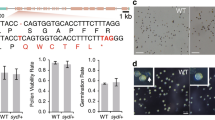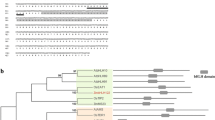Abstract
Polycomb group (PcG) proteins form Polycomb Repressive Complex 2 (PRC2), which regulates seed development by the epigenetic control of gene expression. Interaction assay among Arabidopsis Fertilization-independent-seed2 (FIS) class PcG proteins showed that Fertilization-independent endosperm (FIE) interacts with Medea (MEA), a SET-domain polycomb protein, of which N-terminal region is crucial for the interaction. In this study, rice SET-domain PcG protein OsEZ1, also known as OsiEZ1 in indica rice, was analyzed to identify an interacting domain of OsEZ1 required for OsEZ1–OsFIE2 protein interaction. A series of OsEZ1 deletions were generated and used to determine an interacting domain of OsEZ1 with OsFIE2 using the yeast two-hybrid system. Among OsEZ1 deletions, only OsEZ1∆2 and OsEZ1∆3 interacted with OsFIE2, indicating that the 155K–169R or N-proximal region of OsEZ1 is crucial for OsFIE2–OsEZ1 interaction. To examine the physiological roles of OsEZ1, 35S:OsEZ1 Arabidopsis lines were generated. OsEZ1 overexpressors exhibited altered seedling growth and seed size, implying that OsEZ1 may play important roles in seedling and seed development.





Similar content being viewed by others
References
Baroux C, Gagliardini V, Page DR, Grossniklaus U (2006) Dynamic regulatory interactions of Polycomb group genes: MEDEA autoregulation is required for imprinted gene expression in Arabidopsis. Genes Dev 20:1081–1086
Bouyer D, Roudier F, Heese M, Andersen ED, Gey D, Nowack MK, Goodrich J, Renou JP, Grini PE, Colot V, Schnittger A (2011) Polycomb repressive complex 2 controls the embryo-to-seedling phase transition. PLoS Genet 7:e1002014
Butenko Y, Ohad N (2011) Polycomb-group mediated epigenetic mechanisms through plant evolution. Biochim Biophys Acta 1809:395–406
Chanvivattana Y, Bishopp A, Schubert D, Stock C, Moon YH, Sung ZR, Goodrich J (2004) Interaction of Polycomb-group proteins controlling flowering in Arabidopsis. Development 131:5263–5276
Clough SJ, Bent AF (1998) Floral dip: a simplified method for Agrobacterium-mediated transformation of Arabidopsis thaliana. Plant J 16:735–743
Danilevskaya ON, Hermon P, Hantke S, Muszynski MG, Kollipara K, Ananiev EV (2003) Duplicated fie genes in maize: expression pattern and imprinting suggest distinct functions. Plant Cell 15:425–438
Goodrich J, Puangsomlee P, Martin M, Long D, Meyerowitz EM, Coupland G (1997) A Polycomb-group gene regulates homeotic gene expression in Arabidopsis. Nature 386:44–51
Grossniklaus U, Vielle-Calzada JP, Hoeppner MA, Gagliano WB (1998) Maternal control of embryogenesis by MEDEA, a polycomb group gene in Arabidopsis. Science 280:446–450
Hermon P, Srilunchang KO, Zou J, Dresselhaus T, Danilevskaya ON (2007) Activation of the imprinted Polycomb Group Fie1 gene in maize endosperm requires demethylation of the maternal allele. Plant Mol Biol 64:387–395
Jeong CW, Roh H, Dang TV, Choi YD, Fischer RL, Lee JS, Choi Y (2011) An E3 ligase complex regulates SET-domain polycomb group protein activity in Arabidopsis thaliana. Proc Natl Acad Sci USA 108:8036–8041
Kapazoglou A, Tondelli A, Papaefthimiou D, Ampatzidou H, Francia E, Stanca MA, Bladenopoulos K, Tsaftaris AS (2010) Epigenetic chromatin modifiers in barley: IV. The study of barley polycomb group (PcG) genes during seed development and in response to external ABA. BMC Plant Biol 10:73
Katz A, Oliva M, Mosquna A, Hakim O, Ohad N (2004) FIE and CURLY LEAF polycomb proteins interact in the regulation of homeobox gene expression during sporophyte development. Plant J 37:707–719
Kinoshita T, Harada JJ, Goldberg RB, Fischer RL (2001) Polycomb repression of flowering during early plant development. Proc Natl Acad Sci USA 98:14156–14161
Liang YK, Wang Y, Zhang Y, Li SG, Lu XC, Li H, Zou C, Xu ZH, Bai SN (2003) OsSET1, a novel SET-domain-containing gene from rice. J Exp Bot 54:1995–1996
Liu X, Kim YJ, Muller R, Yumul RE, Liu C, Pan Y, Cao X, Goodrich J, Chen X (2011) AGAMOUS terminates floral stem cell maintenance in Arabidopsis by directly repressing WUSCHEL through recruitment of Polycomb Group proteins. Plant Cell 23:3654–3670
Luo M, Platten D, Chaudhury A, Peacock WJ, Dennis ES (2009) Expression, imprinting, and evolution of rice homologs of the polycomb group genes. Mol Plant 2:711–723
Na JK, Seo MH, Yoon IS, Lee YH, Lee KO, Kim DY (2012) Involvement of rice Polycomb protein OsFIE2 in plant growth and seed size. Plant Biotech Rep 6:339–346
Ng DW, Wang T, Chandrasekharan MB, Aramayo R, Kertbundit S, Hall TC (2007) Plant SET domain-containing proteins: structure, function and regulation. Biochim Biophys Acta 1769:316–329
Ohad N, Yadegari R, Margossian L, Hannon M, Michaeli D, Harada JJ, Goldberg RB, Fischer RL (1999) Mutations in FIE, a WD polycomb group gene, allow endosperm development without fertilization. Plant Cell 11:407–416
Pien S, Grossniklaus U (2007) Polycomb group and trithorax group proteins in Arabidopsis. Biochim Biophys Acta 1769:375–382
Reyes JC, Grossniklaus U (2003) Diverse functions of Polycomb group proteins during plant development. Semin Cell Dev Biol 14:77–84
Spillane C, MacDougall C, Stock C, Kohler C, Vielle-Calzada JP, Nunes SM, Grossniklaus U, Goodrich J (2000) Interaction of the Arabidopsis polycomb group proteins FIE and MEA mediates their common phenotypes. Curr Biol 10:1535–1538
Springer NM, Danilevskaya ON, Hermon P, Helentjaris TG, Phillips RL, Kaeppler HF, Kaeppler SM (2002) Sequence relationships, conserved domains, and expression patterns for maize homologs of the polycomb group genes E(z), esc, and E(Pc). Plant Physiol 128:1332–1345
Thakur JK, Malik MR, Bhatt V, Reddy MK, Sopory SK, Tyagi AK, Khurana JP (2003) A polycomb group gene of rice (Oryza sativa L. subspecies indica), OsiEZ1, codes for a nuclear-localized protein expressed preferentially in young seedlings and during reproductive development. Gene 314:1–13
Wang D, Tyson MD, Jackson SS, Yadegari R (2006) Partially redundant functions of two SET-domain polycomb-group proteins in controlling initiation of seed development in Arabidopsis. Proc Natl Acad Sci USA 103:13244–13249
Xiao W, Brown RC, Lemmon BE, Harada JJ, Goldberg RB, Fischer RL (2006) Regulation of seed size by hypomethylation of maternal and paternal genomes. Plant Physiol 142:1160–1168
Yadegari R, Kinoshita T, Lotan O, Cohen G, Katz A, Choi Y, Nakashima K, Harada JJ, Goldberg RB, Fischer RL, Ohad N (2000) Mutations in the FIE and MEA genes that encode interacting polycomb proteins cause parent-of-origin effects on seed development by distinct mechanisms. Plant Cell 12:2367–2382
Acknowledgments
This work was supported by a grant from the Next-Generation BioGreen 21 Program (SSAC, Grant#: No. PJ00951407), Research Program for Agricultural Science and Technology Development (Project No. PJ008677), and Postdoctoral Fellowship Program of National Academy of Agricultural Science, Rural Development Administration, Republic of Korea.
Author information
Authors and Affiliations
Corresponding author
Rights and permissions
About this article
Cite this article
Na, JK., Seo, MH., Moon, SJ. et al. N-terminal region of rice polycomb group protein OsEZ1 is required for OsEZ1–OsFIE2 protein interaction. Plant Biotechnol Rep 7, 503–510 (2013). https://doi.org/10.1007/s11816-013-0288-x
Received:
Accepted:
Published:
Issue Date:
DOI: https://doi.org/10.1007/s11816-013-0288-x




